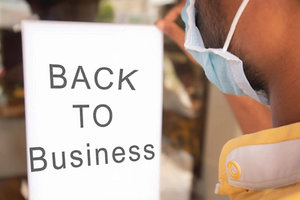The chiropractic profession, like many professions, has encountered devastating setbacks this year because of a novel viral disease: COVID-19. The "new normal" protocols require changes in behavior, so I'd like to offer suggestions that might benefit you and your patients. Whether your town has been severely impacted by the pandemic or minimally, I suggest this article benefits both you and your patients.
America endured annual epidemics that became more and more severe. During the late 1940s to the early 1950s, CDC data indicate that polio paralyzed approximately 35,000 Americans per annum. This viral disease created the need for a novel technology, one that enabled the infected patients to breathe; it was the "iron lung." Fortunately, a disruptive technology, the Salk and Sabin vaccines, eliminated the polio virus and ended epidemic in America during 1979.
"Throughout the 1955 epidemic, practically all of Boston Children's wards were dedicated to treating polio patients, with nurses and doctors working extraordinary around-the-clock shifts. In August 1955, the number of patients in the hospital rose above what was considered the maximum possible, with 66 percent of all patients at the hospital receiving treatment for polio."1
 While medical science rushes to create a new vaccine to protect us against the coronavirus, we must continue to treat our patients! Fortunately, chiropractic offices are once again offering health care services to patients in need of relief of pain and suffering. Yet the novel viral infection persists. Hence, we must now realize that "new normal" protocols are required; in fact, we may never return to the pre-COVID protocols. With that in mind, I would like to share some do's and don'ts for chiropractic physicians to consider.
While medical science rushes to create a new vaccine to protect us against the coronavirus, we must continue to treat our patients! Fortunately, chiropractic offices are once again offering health care services to patients in need of relief of pain and suffering. Yet the novel viral infection persists. Hence, we must now realize that "new normal" protocols are required; in fact, we may never return to the pre-COVID protocols. With that in mind, I would like to share some do's and don'ts for chiropractic physicians to consider.
The Do's
Do practice kindness with your patients. At this time, many patients are fearful of becoming infected and unaware of dangers of this novel virus.2 Be the voice of empathy and strength you have always been as a doctor of chiropractic. It is needed now more than ever.
Do have your employees notify patients that you are implementing new protocols to provide for a safe treatment environment. Patients will appreciate your efforts to make the clinic safe for them.
Do realize that your patients may present to you with the signs and symptoms of COVID-19. Here is a brief report from one of my residents who cares for patients within the confines of a Federally Qualified Health Center. He contracted the disease and recovered. Fortunately, his case was mild. You might identify future patients with these symptoms.
At the end of March, I contracted Covid-19. My first instinct was that it was allergies. I had gone on a hike and didn't feel anything until later that evening. The pollen was very high that day, which I presumed caused the mild stuffy nose, sneezing and mild dry coughing. The coughing did not stop right away, but it wasn't uncontrollable or overwhelming.
When the coughing subsided a day later, fatigue subsequently followed. I started feeling more exhaustion when performing normal activities of daily living and especially when working out. When entering the workspace, I had no fevers and I was always within my normal range, but then one day after work I felt warm and slightly lightheaded. It was not anything that I thought warranted concern. I assumed I was just tired from a long day at work while wearing a mask.
My significant other said that I felt warm to the touch. We then took my temperature and realized that it was outside of my normal range and I had a low-grade fever of 101. We repeated this process about 10 minutes later to make certain it was not a false reading, but it was still above 100 degrees.
After a good night's sleep I felt fine and had no fever. My temperature was tested again when arriving at work and there were no issues. At that point, I spoke with my co-workers, got tested for influenza and that came back negative. Once I got a negative reading, I ultimately got tested for Covid-19. Due to concern and spread mitigation I went home to quarantine just in case my results were positive. I was contacted expediently and informed that I had COVID-19.
My symptoms were mild and generally lasted within a five-day period. I could not tell you where I contracted the virus, but I had been doing my due diligence to make sure that I was being safe. The only symptoms that lingered for about 10 days were the loss of smell and taste, which you can imagine was not a pleasant experience. I quarantined for two-and-a-half weeks while making it a point to take immune-boosting, antiviral supplements to help ward off the issue. I truly am fortunate to have recovered without any persistent effects.
Do help prevent the spread of the virus by using personal protection equipment (PPE).3 All personnel working in the chiropractic facility should be wearing masks. You might consider wearing scrubs and using gloves. Realize that you may take the virus home with you if infected droplets are on your clothing.
Do a fever screen on each patient prior to admittance for care. All employees should also be tested for an elevated body temperature at the beginning of the work day. I suggest the use of a non-contact infrared thermometer.
Do disinfect all treatment tables, instruments, and furniture in the waiting room and treatment rooms between patient interventions.
Do consider the use of telemedicine. Many patients would prefer to reduce opportunity costs and exposure to the virus with a telephone or other type of (Zoom, etc.) communication with their chiropractor. Of course, telemedicine will not replace the hands-on experience, but it might enhance your health care delivery system.
The Don'ts
Don't discuss the concept of "herd immunity" with patients or suggest that it is only affecting the elderly and those with special needs / health conditions. You patients cherish their loved ones and do not appreciate any notion that their lives are any less important than anyone else's.4
Don't spread misinformation and conspiracy theories regarding vaccines or the COVID-19 pandemic. There is already far too much of this going around. You might want to consider using epidemiology terminology when discussing the issue, and express hope that effective strategies to flatten the curve and cure the disease will soon become a reality. (This is also a great time to discuss the power of the immune system with patients and natural ways they can boost their immunity against infection including the coronavirus.)
The World Health Organization (WHO) has called the situation an infodemic: "An over-abundance of information — some accurate and some not — rendering it difficult to find trustworthy sources of information and reliable guidance."5
I wish all of you success and happiness. We will get through these challenging times. Do not forget that we must face the "new normal," move on with our lives and practices, and continue to reduce pain and suffering with our clinical skills and kindness in our hearts.
References
- McAlpine KJ. "Culture Shock: Why the Polio Virus Had to Live Before It Had to Die." Vector, Boston Children's Hospital, April 20, 2017.
- "Why Practicing Medicine With Kindness Matters." Becker's Hospital Review.
- "Rational Use of Personal Protective Equipment for Coronavirus Disease (COVID-19) and Considerations During Severe Shortages: Interim Guidance." World Health Organization, April 6, 2020.
- Lanese N. "Sweden's Lax COVID-19 Response Caused Too Many Deaths, Country's Top Epidemiologist Says." Live Science, June 5, 2020.
- Ball P, Maxmen A. "The Epic Battle Against Coronavirus Misinformation and Conspiracy Theories: Analysts Are Tracking False Rumors About COVID-19 in Hopes of Curbing Their Spread." Nature, 27 May 2020.
Click here for previous articles by James Lehman, DC, MBA, DIANM.





